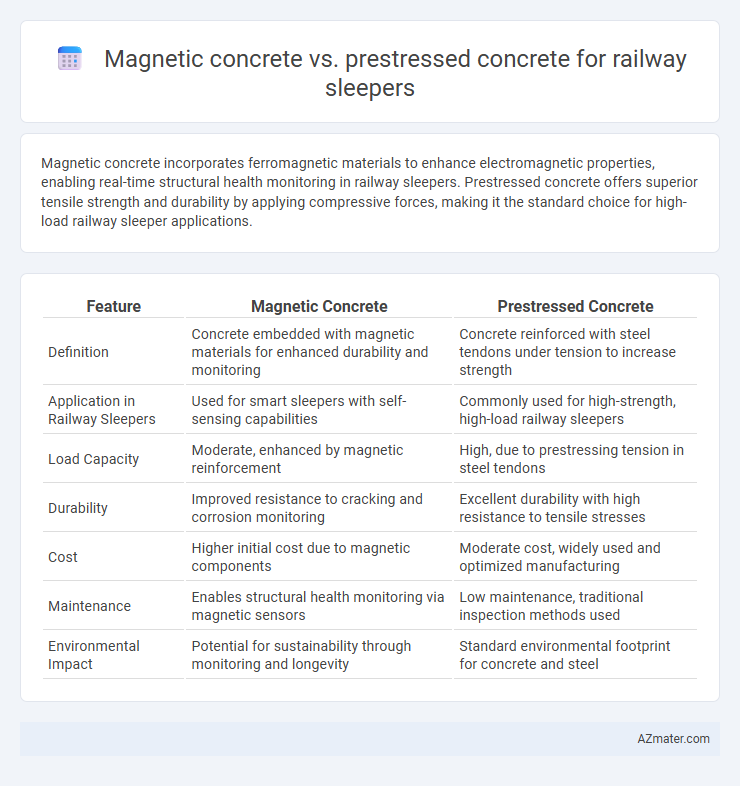Magnetic concrete incorporates ferromagnetic materials to enhance electromagnetic properties, enabling real-time structural health monitoring in railway sleepers. Prestressed concrete offers superior tensile strength and durability by applying compressive forces, making it the standard choice for high-load railway sleeper applications.
Table of Comparison
| Feature | Magnetic Concrete | Prestressed Concrete |
|---|---|---|
| Definition | Concrete embedded with magnetic materials for enhanced durability and monitoring | Concrete reinforced with steel tendons under tension to increase strength |
| Application in Railway Sleepers | Used for smart sleepers with self-sensing capabilities | Commonly used for high-strength, high-load railway sleepers |
| Load Capacity | Moderate, enhanced by magnetic reinforcement | High, due to prestressing tension in steel tendons |
| Durability | Improved resistance to cracking and corrosion monitoring | Excellent durability with high resistance to tensile stresses |
| Cost | Higher initial cost due to magnetic components | Moderate cost, widely used and optimized manufacturing |
| Maintenance | Enables structural health monitoring via magnetic sensors | Low maintenance, traditional inspection methods used |
| Environmental Impact | Potential for sustainability through monitoring and longevity | Standard environmental footprint for concrete and steel |
Introduction to Railway Sleepers: Material Evolution
Railway sleepers historically transitioned from wood to materials like prestressed concrete due to durability and load-bearing advantages. Magnetic concrete, incorporating ferromagnetic particles, offers potential improvements in detecting structural health and increasing electromagnetic shielding around sleepers. The evolution reflects a shift toward multifunctional materials that enhance railway infrastructure performance and maintenance efficiency.
Overview of Magnetic Concrete in Railway Applications
Magnetic concrete in railway sleepers incorporates ferromagnetic materials that enhance durability and resistance to environmental stress compared to traditional prestressed concrete. This innovation improves electromagnetic interference shielding and provides self-sensing capabilities for structural health monitoring in railway infrastructure. The integration of magnetic particles in the concrete matrix offers potential advancements in safety and maintenance efficiency for modern rail networks.
Prestressed Concrete: Definition and Historical Usage
Prestressed concrete is a type of concrete in which internal stresses are introduced before any external loads are applied, enhancing its tensile strength and durability, making it ideal for railway sleepers. Historically, prestressed concrete has been utilized since the early 20th century, with widespread adoption in railway infrastructure due to its ability to withstand heavy loads and reduce track maintenance. Compared to magnetic concrete, prestressed concrete offers superior mechanical performance and longevity, crucial for the demanding conditions of railway sleeper applications.
Structural Properties: Magnetic vs Prestressed Concrete
Magnetic concrete for railway sleepers offers enhanced electromagnetic shielding and improved crack detection capabilities, contributing to longer service life and reduced maintenance costs. Prestressed concrete provides superior load-bearing capacity and resistance to tensile stresses, ensuring high durability under dynamic railway loads. While magnetic concrete introduces multifunctional sensing properties, prestressed concrete remains the industry standard for optimal structural strength and fatigue resistance in railway applications.
Installation and Maintenance Requirements
Magnetic concrete railway sleepers enable rapid, tool-free installation through magnetic alignment systems, reducing labor and downtime compared to prestressed concrete sleepers, which require heavy machinery and precise positioning during installation. Maintenance of magnetic concrete sleepers is minimal due to their corrosion-resistant properties and inherent self-monitoring capabilities, whereas prestressed concrete sleepers demand regular inspection for cracks and tension loss in steel tendons to ensure structural integrity. The streamlined installation and reduced maintenance costs of magnetic concrete sleepers present a strategic advantage in large-scale railway infrastructure projects.
Durability and Lifespan Comparison
Magnetic concrete railway sleepers exhibit enhanced durability due to their improved resistance to corrosion and cracking, extending their lifespan beyond 50 years under typical railway loading conditions. Prestressed concrete sleepers demonstrate high durability through controlled pre-tensioning, minimizing tensile stresses and preventing early cracking, with an average service life of 40-50 years. Comparative studies indicate magnetic concrete outperforms prestressed variants in aggressive environmental conditions, providing up to 20% longer service life and reduced maintenance costs.
Cost Analysis: Initial and Long-term Perspectives
Magnetic concrete sleepers typically incur higher initial costs than prestressed concrete due to advanced materials and manufacturing processes required for magnetic properties. Over the long term, prestressed concrete offers cost advantages through proven durability, lower maintenance needs, and widespread industry acceptance in railway infrastructure. Investment in magnetic concrete may yield specialized benefits but demands careful evaluation against its higher upfront expense and uncertain lifecycle costs.
Environmental Impact and Sustainability Factors
Magnetic concrete incorporates ferromagnetic materials that enable electromagnetic induction for self-sensing railway sleepers, reducing the need for external monitoring systems and promoting longer service life, which lowers material waste and environmental footprint. Prestressed concrete sleepers, widely used in railways, optimize structural efficiency by applying tensile stress to counteract loads, resulting in enhanced durability and reduced maintenance frequency, thus decreasing resource consumption and emissions over their lifecycle. Both materials contribute to sustainable railway infrastructure, but magnetic concrete's self-monitoring capability offers a potential advantage in early fault detection and reduced environmental impact through extended sleeper longevity and minimized intervention.
Performance Under Load and Stress Conditions
Magnetic concrete offers enhanced electromagnetic interference reduction and improved durability under cyclic loading compared to traditional materials, making it suitable for railway sleepers exposed to complex stress environments. Prestressed concrete sleepers exhibit superior load-bearing capacity and crack resistance by incorporating pre-tensioned steel tendons that counteract tensile stresses during rail traffic. Performance under dynamic and static loads favors prestressed sleepers for higher structural integrity, while magnetic concrete provides benefits in electromagnetic applications and moderate load conditions.
Future Trends in Railway Sleeper Technology
Magnetic concrete introduces enhanced electromagnetic properties allowing for real-time monitoring of sleeper stress and structural health, promising predictive maintenance capabilities in railway systems. Prestressed concrete remains dominant due to its superior load-bearing capacity and durability but is increasingly integrated with smart sensors to improve performance diagnostics. Future trends indicate a convergence of these technologies, leveraging magnetic responsiveness in prestressed sleepers for optimized longevity and safety in railway infrastructure.

Infographic: Magnetic concrete vs Prestressed concrete for Railway sleeper
 azmater.com
azmater.com